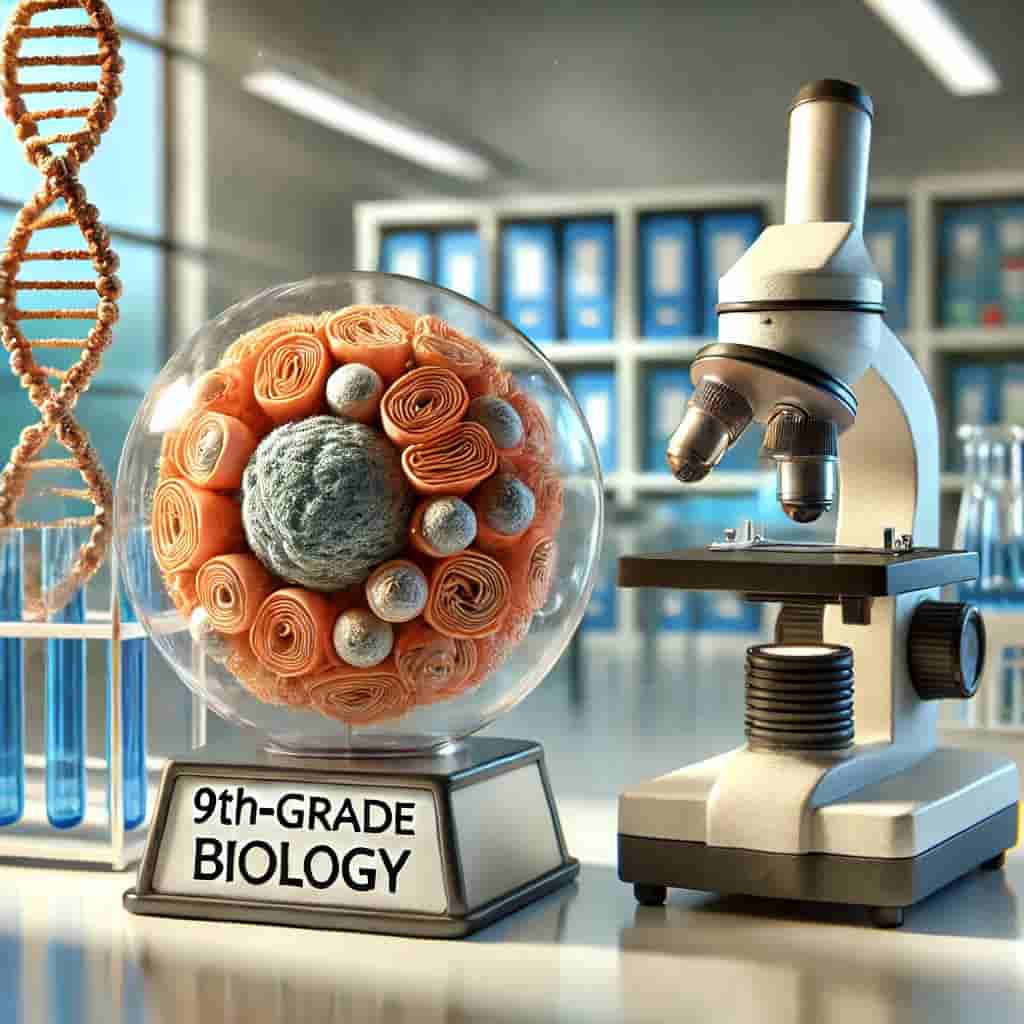Master 9th-grade Biology with this ultimate guide! Learn about cells, life processes, genetics, and the scientific method in a simple, engaging way.
📌 Table of Contents
1️⃣ Introduction – What is Biology?
2️⃣ Major Branches of Biology
3️⃣ What Makes Something Alive?
4️⃣ The Scientific Method – How Biologists Study Life
5️⃣ Tools of a Biologist – How Scientists Study Life
6️⃣ The Metric System – Standard Measurements in Science
7️⃣ Lab Safety Rules – Staying Safe in the Science Lab
8️⃣ Final Thoughts & Key Takeaways
Chapter 1: The Science of Biology
Introduction __ is Biology?
Biology is the study of life and living organisms. It helps us understand how plants, animals, and microorganisms function, survive, and interact with their surroundings. From tiny bacteria to massive whales, biology explains the secrets of life!

Fun Fact: The word “Biology” comes from the Greek words “bios” (life) and “logos” (study)—meaning “the study of life.”
Major Branches of Biology
Biology is a vast field with many specialized branches:
- Botany – Study of plants
- Zoology – Study of animals
- Microbiology – Study of microscopic organisms
- Ecology – Study of ecosystems and environmental interactions
- Genetics – Study of DNA and heredity
These branches help us explore different aspects of life, from individual cells to entire ecosystems!
What Makes Something Alive?
For something to be considered “alive,” it must meet these seven essential characteristics:
✅ Cells – The basic building blocks of life
✅ Metabolism – The ability to use energy
✅ Homeostasis – Maintaining a stable internal environment
✅ Growth & Development – Increasing in size and complexity
✅ Reproduction – Producing offspring
✅ Response to Stimuli – Reacting to the environment
✅ Adaptation & Evolution – Changing over generations to survive
Example: A plant growing toward sunlight is an example of “response to stimuli.”
🔍 The Scientific Method – How Biologists Study Life
Biology is a science, meaning biologists follow a structured process to discover new things. This process is called the Scientific Method, which includes 7 essential steps:
1️⃣ Observation – Noticing something interesting in nature
2️⃣ Question – Asking “Why does this happen?”
3️⃣ Hypothesis – Making an educated guess
4️⃣ Experiment – Testing the hypothesis
5️⃣ Data Collection – Recording the results
6️⃣ Analysis – Understanding the collected data
7️⃣ Conclusion – Accepting or rejecting the hypothesis
Example:
If we give one plant sunlight and another only shade, which one will grow taller? By conducting an experiment and analyzing the results, we can scientifically answer this question!
Tools of a Biologist – How Scientists Study Life
Biologists use advanced tools to explore life at different levels:
Microscopes – To study cells and bacteria
Lab Equipment – Beakers, test tubes, petri dishes
Data Analysis Tools – Graphs, charts, and computer models
Field Equipment – Binoculars, GPS devices, specimen collection kits
These tools allow scientists to make new discoveries and solve real-world biological problems!
The Metric System – Standard Measurements in Science
Scientists worldwide use the metric system for accurate measurements.
✔ Length: Meters (m), centimeters (cm)
✔ Mass: Grams (g), kilograms (kg)
✔ Volume: Liters (L), milliliters (mL)
✔ Temperature: Celsius (°C)
Fun Fact: Water boils at 100°C and freezes at 0°C in the metric system!
⚠️ Lab Safety Rules – Staying Safe in the Science Lab
When conducting experiments, safety is the top priority! Follow these essential lab safety rules:
✔ Wear safety goggles to protect your eyes
✔ Never eat or drink in the lab—chemicals can be dangerous
✔ Handle all chemicals with care and follow instructions
✔ Know emergency procedures and the location of first aid kits
Remember: Science is fun, but safety always comes first!
🎯 Final Thoughts & Key Takeaways
Understanding 9th-grade Biology is not just about memorizing facts—it’s about exploring the living world around us!
📌 Key Takeaways:
🔹 Biology is the study of life and living organisms.
🔹 Organisms must meet seven characteristics to be considered “alive.”
🔹 Scientists use the Scientific Method to study biological processes.
🔹 The metric system is the universal standard for scientific measurements.
🔹 Lab safety is crucial for conducting experiments safely.
Keep exploring, stay curious, and enjoy the journey of learning Biology!
